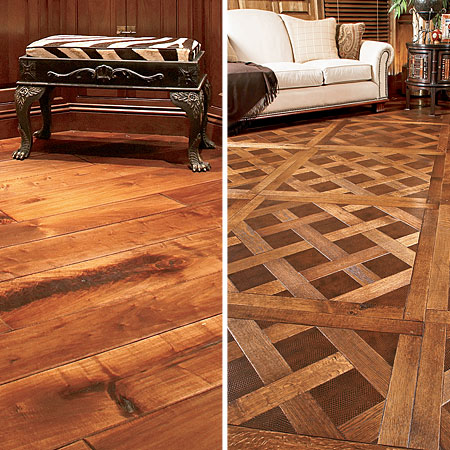
For a home in Indiana, the hand-scraped random-width walnut planks used in a room, left, are from trees felled in a storm; Birger Juell created a parquet floor, right, with white oak salvaged from an 1860s hospital building.
A: Absolutely. Using recycled lumber is a great way to save trees and prevent cut wood from winding up in a landfill. What’s more, planks from old-growth timber are richer in color and denser than wood from younger trees. Secondhand lumber can be turned into elegant flooring featuring everything from modern-looking straight-grained planks to patterned parquets. While it’s true that many recycled planks are peppered with saw kerfs, nail holes, and oil stains, you can also find beams that are less heavily distressed.
For a recycled floor that’s mod rather than rough-hewn, you want wood that underwent less wear and tear in its former life. Recycled lumber is often salvaged from factories, barns, gymnasiums, and other old buildings; support beams and ceiling planks are generally less distressed than floorboards and wall panels. Carlisle Wide Plank Floors (445 N. Wells St., 312-464-0633, wideplankflooring.com) stocks reclaimed antique heart pine, most of it from support beams. Floors made with it are reddish in color and relatively free of flaws. “It’s more formal and less rustic than our other recycled floors,” says Brian Graham, the company’s Chicago showroom manager. Expect to pay about $12 per square foot for this option.
A pair of South Bend, Indiana, homeowners recently recruited Birger Juell (131 Merchandise Mart, 312-464-9663, birgerjuell.com) to create a refined-looking floor from white oak salvaged from ceilings in an 1860s hospital building in Indiana. Staffers from Birger Juell hand-scraped each plank and crafted floors with traditional Versailles parquet. (Hand-scraping allows for further control over the finish of the final product.)
Trees felled by inclement weather are often in good shape, as is lumber salvaged from rivers. At the turn of the century, loggers would float wood down rivers to be milled; some logs became saturated with water and sank to the bottom. Birger Juell president Chuck Crispin says that when they’re rescued from their watery exile, these logs yield floor planks that are particularly fine. “Wood that comes from the bottom of a river is in pristine condition,” he says. “That lumber has basically been in a time capsule for a hundred years.”
Aaron Lindstrom, president of flooring firm Rode Bros. (300 W. Grand Ave., 312-955-9663, rodebrothers.com) says cost-wise, you’ll pay roughly twice as much for a recycled floor as you’d shell out for stock hardwood from a mass-market supplier. He adds that staining old-wood floors ebony, which masks imperfections, is a good way to add instant edge to an interior.
If you prefer the look of new wood or you can’t afford recycled lumber, look to other sustainable hardwood options, which tend to cost only about 20 percent more than stock hardwood. Rode Bros. creates floors not just with reclaimed lumber but also with eco-friendly wood harvested from managed forests no more than 500 miles from Chicago. The firm recently used sustainable materials to create modern hardwood flooring in a Bucktown home. A light gray stain and an ultra-matte finish suited the clients’ contemporary aesthetic and the building’s glass and metal architecture. “It looks very industrial, very modern,” says Lindstrom. “It’s not rustic at all.”
Have a design or renovation question? Just drop us a note at chicagohome@chicagomag.com and we’ll do our best to answer it. Sorry, we cannot take questions by phone, or guarantee individual responses.


